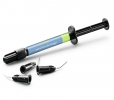The new Minamata Convention on Mercury, which entered into legal force in August 2017, envisions a transition to a mercury-free environment for all. As you probably know, its dental amalgam provisions require each party to the treaty, including the United States, to reduce amalgam use. But you might not know that the convention also lays out a road map that can benefit the dental profession in many ways.
As the Minamata Convention is implemented in the United States and around the world, here’s what dentists can to look forward to.
1. Practicing the modern dentistry you want to practice
As part of the World Alliance for Mercury-Free Dentistry, we’ve worked with a lot of dentists, from private practitioners to public health providers — and they’re excited about new dental technology, including the latest generation of mercury-free fillings. But third-party payers, including dental insurance policies and government programs, often do not fully cover mercury-free fillings in posterior teeth, forcing dentists into a Scylla-Charybdis choice: turn away patients who cannot afford to pay more than their insurance covers or use a polluting mercury product in their offices. The state of Connecticut even refuses to permit amalgam-free dentists to serve adult Medicaid patients, telling them, “If your office cannot provide amalgam services, please have your patients call the Connecticut Dental Health Partnership ... to locate a new dental home.”
The Minamata Convention urges countries to stop these third-party payers from interfering with how dentists practice by “Discouraging insurance policies and programmes that favour dental amalgam use over mercury-free dental restoration” and “Encouraging insurance policies and programmes that favour the use of quality alternatives to dental amalgam for dental restoration.” This will free dentists to practice the 21st-century dentistry that they want to practice — and that their patients deserve.
2. Having more restorative choices
Necessity is the mother of invention, and nowhere is this more true than in the dynamic world of dentistry. Already a range of mercury-free restorative options have revolutionized the way dentists practice. As the European Commission’s Scientific Committee on Emerging and Newly Identified Health Risks (SCENIHR) explains, mercury-free dental fillings “have facilitated a radical change in the concepts of restorative dentistry through the introduction of more minimally invasive techniques and the associated retention of more tooth substance when treating caries.” A World Health Organization report sums it up: “Adhesive resin materials allow for less tooth destruction and, as a result, a longer survival of the tooth itself.”
The Minamata Convention gives dental innovation an extra boost, calling on countries to do even more by “Promoting research and development of quality mercury-free materials for dental restoration.” The end result will be more – and better – restorative choices for dentists and their patients.
3. Providing patients the dental care they want
No dentist wants patients unhappy with their treatment. Nonetheless, we routinely hear from patients dissatisfied with their amalgams, such as a sad phone call from a father whose four-year-old daughter had received an amalgam restoration and it was not until afterward that he learned it contained mercury. This father echoes the concerns raised by the U.S. Food and Drug Administration (FDA)’s dental amalgam rule that concludes:
“The developing neurological systems in fetuses and young children may be more sensitive to the neurotoxic effects of mercury vapor. Very limited to no clinical information is available regarding long-term health outcomes in pregnant women and their developing fetuses, and children under the age of 6, including infants who are breastfed.”
The Minamata Convention aims at reducing overall amalgam use and “Promoting the use of cost-effective and clinically effective mercury-free alternatives for dental restoration” instead, which would go a long ways in eliminating this source of patient dissatisfaction that dentists and their staffs face. Fortunately for the many parents like my discontented caller, some countries are reducing amalgam use by taking precautionary steps to stop amalgam use in children. For example, the European Union is ending amalgam use in deciduous teeth, children under age 15, pregnant women and breastfeeding mothers as of July 1, 2018, with only very limited exemptions. Since a happy parent means a returning patient, this can be a win for both dentists and patients.
4. Improving the dental office environment
High levels of mercury are often recorded in the air of dental offices — the environment where dentists, hygienists, dental assistants and dental office personnel spend most of their working lives. For example, one study found that 122 of the 180 dental offices visited had environmental mercury measurements in one or more locations above the UK occupational exposure standard. And it’s not just the air; mercury has been detected in dental offices’ piping systems, sinks and carpeting as well.
The Minamata Convention recognizes that best management practices alone cannot solve this problem. Only by “phas[ing] down the use of dental amalgam” can this source of mercury in the dental office environment be eliminated. An improved dental office environment is a real plus for the whole dental team.
5. Protecting the community’s environment
As health professionals, all dentists have an interest in protecting the public health, including both oral health and environmental health. Dental amalgam is approximately 50 percent mercury. Between 226 and 322 metric tons of mercury was used for amalgam in 2015 alone, accounting for about 19 percent of global consumption of mercury-added products. Much of this dental mercury eventually enters the environment via pathways such as cremation, dental clinic emissions, sludge incineration and human waste. From there, amalgam’s elemental mercury can convert to methylmercury, which can contaminate the fish people eat and damage children’s developing brains and nervous systems even before they are born.
The Minamata Convention urges countries to start “Setting national objectives aiming at minimizing [amalgam] use” while promoting mercury-free alternatives, both measures that will help protect our environment from this significant source of mercury pollution. And with green consumerism on the rise, it can turn into more business for environmentally responsible dental offices, too. So, dentists should go ahead and advertise what they are doing to protect their communities from mercury pollution!
The Minamata Convention is poised to benefit the environment, and if we seize this opportunity, it will benefit dentists and the patients they serve, too.



